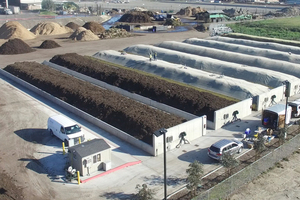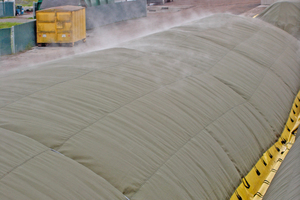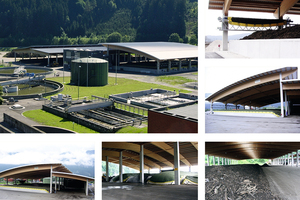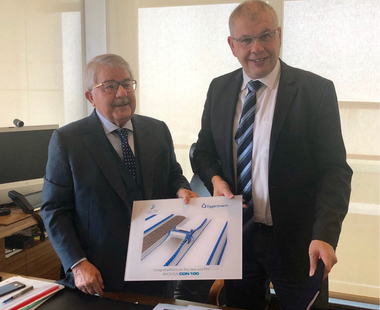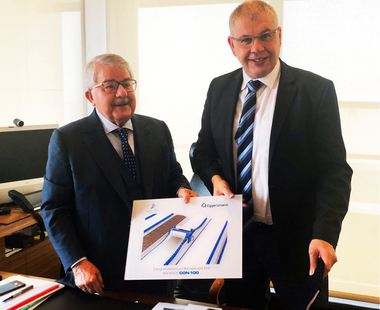Cost- and eco-efficient composting with GORE® Cover System Technology
The European Parliament‘s requirement is clear: member states must ensure that biowaste is either collected separately or recycled at source by the end of 2023. This is what is written in the „Waste Framework Directive“. So time is pressing for municipalities to look at industrial composting systems. One cost-effective and eco-efficient way to obtain high-quality compost from the organic matter that will be generated in the future is to cover or operationally enclose the composting plant with special semi-permeable membranes. One of the market leaders in this field is GORE® Cover System technology.
Over the past 25 years, the separate collection and recycling of organic waste has established itself as an important part of the circular economy. According to the German BGK (Bundesgütegemeinschaft Kompost), the composting and biogas plants that participate in the BGK‘s RAL quality assurance system recycle around 13 million t of organic waste and residual materials each year, turning them into quality-assured composts or fermentation products. In this way, they close the natural nutrient cycle.
Those who recycle biowaste not only recover plant nutrients, but also provide soils with composts and soil conditioners. This sustainable process conserves finite resources and supports the build-up of humus in the soil. Targeted humus management ensures long-term soil fertility, which in turn is the basis for the future cultivation of food, feed and energy crops. Depending on the nutrient content, mature compost is also a complete fertilizer and can thus make the use of chemical fertilizers superfluous. Finally, as a substitute for peat, compost can be used in horticulture in a climate-friendly way: When peat is applied to soils, the greenhouse effect is amplified because fossil carbon is respired; with compost, these negative effects are eliminated.
Social relevance of industrial composting
Industrial composting therefore has a high social value. This was also confirmed by the European Parliament in a press release after it approved four amendment directives included in the so-called „waste package“ in 2018. The EU‘s Waste Framework Directive, which was revised at the time, requires member states to ensure, among other things, that bio-waste is either collected separately or recycled at source by the end of 2023. Time is therefore pressing for municipalities to look into composting systems in order to recycle the organics that will be generated in the future in a sensible way.
Industrial composting is a natural but technically controlled process in which the natural conditions for the decomposition of organic matter in the soil are optimized. Microbes and microorganisms use atmospheric oxygen to convert large portions of the organic material into humus after application. Typically, this process takes 6 to 8 weeks. By comparison, home garden composting can be expected to take one to two years.
For industrial composting, the environmental conditions are kept at an optimum. The same processes therefore run at a greatly accelerated rate. Fluctuations in temperature and humidity due to weather conditions are mostly switched off. Thus, the microorganisms always find optimal conditions for their work.
Advantages of closed composting
Professional composting processes differ enormously: Open systems such as open-air windrow composting are considered economical, simple and flexible. Open systems have longer rotting times of about 19 weeks on average and are highly dependent on climatic conditions such as temperature and humidity without additional measures. In addition, odor emissions are released in the course of each composting operation, which can only be controlled to a very limited extent with an open system.
In closed systems in halls, boxes, containers or tunnels, composting takes place under optimized conditions, resulting in less odor and a reduction in rotting time, as well as better control of emissions, with an equivalently high production capacity. Open and closed systems are often combined, depending on which phase the composting is in.
Semipermeable membrane cover as an equivalent alternative
A cost- and eco-efficient alternative to closed composting in halls, tunnels, boxes or containers is the cover or operational enclosure of the composting plant with special semipermeable membranes. It offers plant operators an identical performance profile and equal environmental protection – with significantly reduced costs and equivalent emission control of highly volatile, odorous, organic substances, (metabolites) and other contaminants. A 2014 study by the Environmental Institute (Umweltinstitut GmbH (bifa)) assigns membrane composting the best eco-efficiency.
Simple and innovative: Cover technology GORE® Cover
One such semi-permeable membrane is the Gore Cover membrane developed in Germany by the global company W. L. Gore & Associates, which has one of its headquarters in near Munich/Germany. Gore is a leading company in the processing of polytetrafluoroethylene, or PTFE. With more than 20 years of market presence, GORE® Cover is one of the world‘s leading treatment technologies with semi-permeable covers. In the GAS region alone, around 100 GORE® Cover composting plants are currently in operation, with throughputs ranging from 2000 to over 200 000 t/a. The all-in-one solution is a highly simple system with minimal space requirements that is economical to install and operate. The stable and highly durable Gore Cover laminate consists of three layers: in the middle is a PTFE membrane. The outer layers are each made of polyester fabric. The laminate completely encloses the rotting material so that it is physically sealed off from the outside - without the need for a building or even a biofilter system, which is not necessary due to the special membrane properties of GORE® Cover to effectively control odors and emissions: According to the 2017 U.S. study report „Evaluating Options for Controlling Air Emissions from Composting Operations“ by Chuck Schmidt and Tom Card regarding the retention of volatile organic compounds, measurement results for various organic input materials indicate relative emissions control (below to above the cover) of up to 98 % when best practices are used in operations. Cover technology is recognized as a „best available technique“ (BAT) for reducing fugitive emissions of dust, odor, and bioaerosols under the European Emissions Directive and the corresponding BAT conclusion.
GORE® Cover also meets the requirements of regulatory agencies in the EU and North America alike, including those of authorities in Germany in the Technical Instructions on Air Quality Control (TA Luft), the UK in the Animal By-Products regulation, and in California the „1133.3 VOC Control for Foodwaste/Greenwaste Composting“ rule.
The tarpaulins typically last 7 to 8 years in Central European climatic conditions, although they are usually still used as sections to cover against rain in storage after that. If they do need to be disposed of, this can be done in commercial waste. Gore also offers recycling for cleaned tarpaulins.
More than a cover: GORE® Cover System Technology
GORE® Cover is a ready-made tarpaulin supplied by W. L. Gore & Associates with various designs such as edge seals and hand loops to trained plant engineers. They add the other necessary components, do the design of the composting equipment, and are present during subsequent construction and commissioning. Comprehensive training of operators and good support of the plant during operation are further important components of the system concept and ensure optimal and sustainable operation of the treatment and composting process.
Essentially, the Gore Cover system consists of three components: the membrane cover, the aeration, and the control. Their combination enables an economical and reliable composting process.
Cover technology
Due to its membrane pore structure, the Gore Cover laminate has semi-permeable properties that enable a constant windrow climate. It is waterproof and windproof and thus protects the rotting material against wind and weather and thus against undesirable rotting processes caused by wetting. Thanks to its water vapor and air permeability, it also regulates moisture discharge and allows air and CO2 to escape without causing the rotting material to dry out.
At the same time, the cover acts as a physical barrier to odor and climate-relevant emissions of volatile organic substances escaping from the rotting material. The vapor generated by the temperature development during decomposition under the cover condenses out as a fine film on the inside of the cover. Volatile organic components such as odorous substances dissolve within this condensed film and drip back into the windrow, where they are further degraded by bacteria and microorganisms.
With a pore size of approximately 0.2 μm, the membrane cover is also an effective barrier against spores and germs. Comparative tests have proven that the system reduces the emission of bio-aerosols by more than 99 %, thus ensuring the protection of plant workers and residents. As required by law, pathogenic microbes are safely killed by the heat generated during the treatment process.
Aeration system
Oxygen is required as needed for the decomposition of organic material by so-called aerobic microorganisms. An aeration system creates the necessary conditions for this and thus accelerates the normal composting process: aeration channels are installed on or in the ground. The greater the throughput of the plant, the more worthwhile it is to invest in underfloor aeration ducts, which enable the plant to be driven over and save on personnel costs. Pressure aerators are connected to the aeration ducts. They push or force air through the compost pile to ensure sufficient oxygen supply. This is done either via a control system oriented to the oxygen content in the heap, or according to a preset interval mode, whereby the intervals are adapted to the respective phase of the rotting process. This approach ensures low operating costs of about 1.5 kWh of electricity per ton of compost. Thanks to the positive aeration, a slight overpressure is created in the sealed system, which leads to a uniform temperature distribution in the entire windrow body and causes a more uniform hygieneization of the rotting material.
Regulation of the process with oxygen and temperature sensor
Stainless steel probes installed directly in the main body of the windrow measure oxygen content and temperature data, which are stored and evaluated by means of special software. Radio and remote monitoring of the composting process is possible. Thanks to the sensor-controlled aeration system, which supplies the windrow with oxygen from the bottom evenly and as needed, and the optimal moisture management provided by the semi-permeable properties of the GORE® Cover, an optimal environment is created for the microorganisms in every rotting phase. The on-demand ventilation also significantly reduces odor emissions, and the quality of the compost is enhanced. Since a slight overpressure is created underneath the tarpaulin, a homogeneous flow through the rotting material is ensured in all corners, so that no zones lacking oxygen can occur. This ensures complete hygienization at all times.
Phases of the GORE® Cover Composting Process
The composting process with GORE® Cover takes between 2 and 8 weeks, depending on local regulations and the end user‘s compost – specifications, with 6-8 weeks being the norm. A typical process can be divided into four phases.
Pre-sorting
The biowaste is first delivered to the receiving hall, where it is mechanically processed, appropriately supplemented with structural material, and homogenized before being built up into a heap on the aeration channels by wheel loaders. The GORE® cover is then immediately pulled over the pile and then the probes are sunk into the material to be composted. Toward the bottom, the compost pile is sealed to the outer silo walls with edge weights or, in the case of traveling silo designs, with the aid of a tensioning system. Various handling aids are available for these operations – for example, a winding device for rolling up and unrolling the cover and a fire hose to be filled with water or sand or carabiner tensioning rope systems for fixing and sealing the cover. Downstream installations such as a biofilter to reduce emissions are not necessary. Here, nature does the work. This is cost-effective and ecologically perfectly coordinated. The subsequent composting process with GORE® Cover takes only eight weeks to produce high-quality compost and is divided into three phases:
Phase I
In Phase I, the rotting material usually remains under the GORE® Cover for four weeks. The main or intensive rotting phase is characterized by high temperatures and rapid decomposition of the organic matter. Aeration and humidification can be controlled so that the process is as fast as possible. During this phase, the temperature and time required for hygienization are achieved in order to reliably kill pathogenic germs and weed seeds. In this way, the rotting material remains completely under tarpaulin during its most active phase, so that all emissions generated during this most critical time are controlled in accordance with the specifications.
Phase II
Following this , the measuring probes are removed and the cover is rolled onto the wrapping unit. The rotting material is then homogenized again, for example with the aid of a front loader, and transferred to the treatment units intended for phase II and covered again, the probes are positioned and biological stabilization continues during this phase for 2 more weeks.
Phase III
The subsequent phase III (post-rotting) serves the further maturation of the compost material, which takes place at lower temperatures. This phase is the so-called maturing phase, in which the finished compost is produced from the now almost stabilized compost. Products from the previous phase are converted into humus-forming substances, while microorganisms typical of this phase, such as fungi, break down more stable portions of the organic matter. This is followed by further turning or transport and a change to open composting for about two weeks. Each windrow is thus moved only twice during the entire rotting process. During this period, the temperature in the compost body decreases and the biological activity slowly decreases further.
In summary, then, GORE® Cover enables ecologically, economically and process-efficient composting, while providing reliable protection against odor nuisance and excellent retention of volatile degradation products, which is why it has established itself as one of the market leaders for decades.

